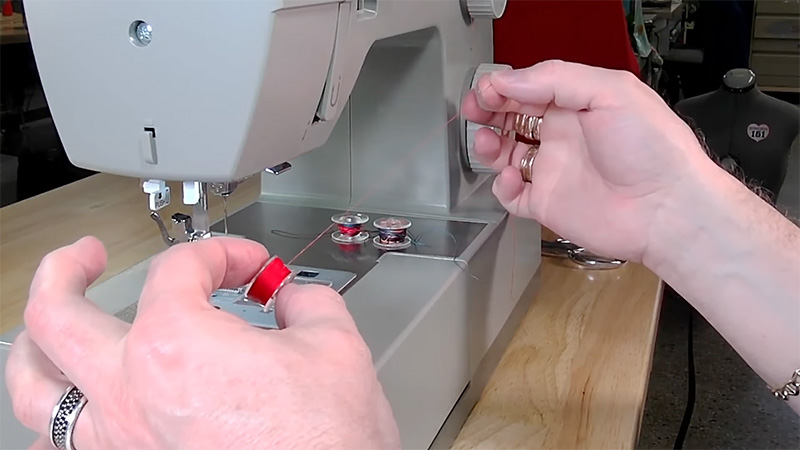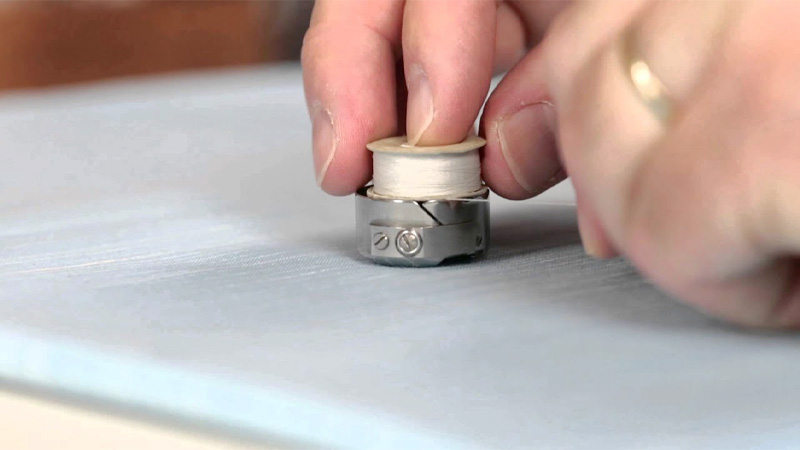One of the fundamentals we have before our eyes but often ignore is the bobbin of our sewing machine. We become so busy in sewing that we forget to frequently check whether it’s doing fine or not. So, what is a bobbin?
We all see and work with a bobbin, but probably can’t define it properly, right? Well, here’s our article for you today.
Even if bobbins may seem very easy to manage and work with, ignore them too often, and you may experience unexpected issues. That’s why it is wise to learn the possible issues you may have with bobbins and why!
Let’s cut the words and start already.

What Is A Bobbin?
As you regularly sew, you must have noticed a small, cylindrical, or spool-shaped tool in your sewing machine. It holds the lower thread you need to sew. The primary objective is to hold the seams together.
The bobbin is the fundamental part of your stitching process. It works synchronously with the upper thread from the needle to craft the stitches on the fabric. You use two types of bobbins in the machine – the front load and the top load.
The front-load bobbins are inserted from the front and need a bobbin case. However, it’s not the same for the top-load bobbins.
Top-load bobbins are visible and inserted from the top of the sewing machine. Unlike the front-load bobbins, they don’t need a case.
Most bobbins are made of metal. But it’s not uncommon to have wooden or plastic bobbins too. Plus, it also depends on the kind of machine you use and thread types!
Note:
Bobbin Tension: In our article, you will meet two terms often – bobbin tension and needle tension. Don’t mix up the two together when they have special meanings.
Bobbin tension is the small amount of pressure exerted between the two elements of the bobbin case on the thread. It determines the details and smoothness of the fabric. The right bobbin tension is between 180 to 220 grams.
Needle Tension: Sometimes, also known as thread tension. It is the amount of thread that your machine can use to complete a stitch. The default needle tension remains usually at 4.5 on a scale from 0-9.
Bobbin Uses and Troubleshooting

Today, we will mainly troubleshoot the issues you can face with bobbin. But before that, let’s learn a bit more about how a bobbin helps you sew,
- Bobbins supply the lower thread for sewing. It helps the upper thread with stitches on the bottom of the fabric.
- It also regulates thread tension. Without the right thread tension, you will have uneven stitches.
- You can organize the upper and lower threads differently to form different types of stitches including straight, zigzag, or any other kind.
- Experts can wind the bobbins following their choice of colors and texture. This is especially useful when your project needs versatile colors and thread combinations.
Common Bobbin Problems & Troubleshooting
You may get tired of reading the words. That’s why we have prepared this table for you with different bobbin issues & their solutions. You are welcome!
| Bobbin Problems You May Face | Possible Underlying Reason | Solutions |
| Tangled Bobbin Thread | 1) Improper threading2) Initial wrong tension 3) Using low-quality 4) Old thread | 1) Open your machine’s manual and follow the instructions to rethread both the upper and lower threads. 2) Check and adjust the bobbin tension. You should match the upper thread tension. 3) Use a good-quality thread for any project. |
| Loops on the Bottom (Also known as uneven stitching) | 1) Damaged bobbin2) Wrong threading3) Wrong bobbin tension | 1) You have to re-adjust the bobbin tension and match the upper thread tension. 2) Examine the threading path and make sure it properly seats in the bobbin case. 3) Look for any damage in the bobbin. Often a knot in thread can result in supply irregularities. |
| Bobbin runs out fast | In case your bobbin thread runs out faster than expected, it may not have been wound correctly or it’s too loosely wound | 1) The best solution is to wind a new bobbin with even thread and sufficient tension. 2) Also, use the right size bobbin for your sewing machine. |
| Bobbin Jams | Bobbin jams can occur due to debris, lint, or thread tangles inside the bobbin case | 1) Remove the bobbin case and clean it thoroughly. 2) Also, ensure that the bobbin is correctly placed and aligned in the bobbin case. |
| Bobbin Won’t Wind | 1) An incorrectly engaged winding mode2) Or, a serious problem with the bobbin mechanism | 1) Examine the bobbin winding spindle and look for any damage. 2) You have to thread it right through the bobbin winding path (if it hasn’t already). 3) Engage the bobbin winding mode correctly on your machine. |
| Bobbin Tension Too Tight or Too Loose | 1) Unstable thread consistency2) Improper tension adjustment3) Damaged bobbin case | 1) Open your machine’s manual and follow the instructions to adjust the bobbin tension to match the upper thread. 2) Use good-quality thread with consistent thickness to avoid tension variations. |
| Bobbin Thread is Not Pulling Up | If the bobbin thread is not being pulled up to the surface when you start sewing, it may be due to incorrect threading or a timing issue with the machine. | 1) You must rethread both the upper and the lower threads. Follow the manual to thread the tension disks right. 2) However, in case the issue still persists, you may need a professional service check. |
Here are some of the common and frequent issues you may experience with your machine bobbin. You can solve most of the bobbin issues by yourself. However, if you don’t, feel free to reach us for professional support. We are all yours!
Last Words
The bobbin may seem like a small part to often leave it unattended. But if you overlook the problems, it can seriously affect the way you sew and your overall work.
We hope our article is useful to you in determining the problem. And you have your answer to what is a bobbin. Share our article with your friends to let them know about us.
Also, leave a comment below and let us know in case you are facing a critical issue with your machine’s bobbin. See you soon with our next article on – how to iron patches.
Leave a Reply